Who is afraid of the Benko? - J'adoube?
In the good all tradition -It has happened again. Another victim. Another kill.
Listening to Rimsky-Korsakov's Scheherazade 'The Sea and Sinbad's Ship', this music brings back sweet memories of a daunting quest to slain your opponent in pieces.
Lamp, F - Montse [A57]
J'adoube enjoy the game.
1.d4 Nf6 2.c4 c5 3.d5 b5 4.cxb5 a6 5.Nc3
The Zaitsev Variation
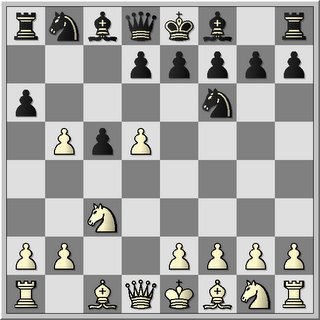
5. axb5
Is a logical answer but alternatives such as 5...Qa5 or 5.. g6 can also be played. Standardly speaking, I just hit the pawn back - is probably best.
6.Nxb5 Qa5+ 7.Nc3 g6 8.Bd2 Bg7 9.e4
Now 6.e4 is a possible continuation and according to IM Steffen Pederson a main line to follow. I tried the aggressive Qa5+. Drawback your queen is early in the game so you have to watch out that it will not become a target. So 7. Nc3 becomes forced and 8.e4 is not immediately possible. So your Knight on f6 is save, for a while at least.
Let's go to position after 8 moves of play.
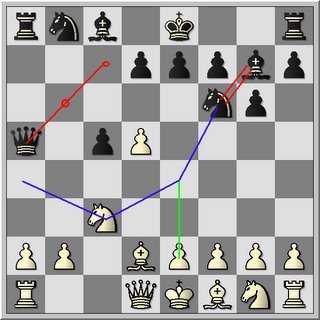
Now white can play. 9. Ne4 hitting with his dark squared bishop the Queen. On Na4 he looses his knight. Black moves Q to b6 on Ne4 (c7 is possible but might not be as strong),and the only remaining target for white's knight is the defended Knight on f6. This type of play would not beneficial for white, as it would not support his development. By the exchange on f6, black's dark squared bishop has been uncovered and starts to pressurize the b2 a1 square holding back the b-pawn. And already black is in for equalisation.
This is defenitely not the type of play you want to have with white.
Well back to the game!
My opponent played the delicious 9.e4 and here we go.
9.e4 d6 10.Bc4?! 0-0 11.Nge2 Nbd7
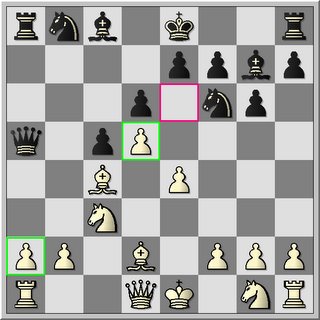
Question what might be the idea of Bc4?
Preventing black to play the freeing break with e6 in the future? Bb5+ looks promising but I would say that if you play for the exchange of your bishop for a knight you are looking for small advantage on long term. This long term advantage would only be possible if you manage to halt black's Q-side play by putting up an effective blockade. Easy to say, but very hard to realize. Also you have to take into account that you have weaken your light squares especially d3-c4. When you played e4 to support d5, d3 cannot be longer controlled by a pawn. On the other hand you killed off a very handy knight that might have been very obstructive in realizing your queen side blockade. There might be extra considerations to be made in view of whether white has a fianchetto structure on the kingside or not.
Whatever the reasoning every game has to be played.
11 Nge2 is Ok, but Nf3 would have been more promising. With Nge2 white does not directly challenge black for the control over e5. His plan is simple. Castle short and use f4 for the break. Open up the f-file for his rook. A question one has to ask oneself is what do I obtain after the execution of the plan.
Well a loss of the pawn, I would say. White does nothing to gain control over the e5 square. So logically speaking, first f4 and then follow up with Nf3.
The only merrit that I see for Nge2 is that it safequards whites castling whithout the necessity to trade off queens. It might strenghten Nc3 but it does not help you on the light squares. So black's strategy becomes very clear. Kill off the light square bishop. Get control over e5, push c5 c4 and put a knight on d3.
Back to the game
12.f4?! Ba6 13.Bxa6 Qxa6 14.0-0 Rfb8 15.Qc2
I don't like 12 f4. The pawn push is not supported. Ba6 forces white into a capture. with this the Q has taken control over the diagonal a6-f1. More imortantly over d3. This calls for a beer. First part of the plan OK - get a grip on d3.
With rook b8 black forces white to protect the b-pawn with the Queen.

Second part of the plan. Get a knight on d3. Importantly, if the knight would be exchanged on d3 you don't want to loose the pawn with it. When you recapture with the pawn you may not loose this pawn. Why? Otherwise you will go into a lost endgame! There will be no stopping of white's pawn march along the a and b-file. Even the translocation of the pawn to the d-file might lead to a position hard to maintain. It comes down to piece cooperation.
Now Ne8 with the idea to translocate the Knight to the Q-side.

16.f5?! Ne5 17.fxg6 hxg6
f5 I don't like neither. It creates a hole on e5. As there is no cooperation with the h-pawn, there is no danger to my kingside. As Silman would say, improve your pieces. With Ne5 black increases its grip on the diagonal a6-f1.
Furthermore, black has only to maneuver his second knight to d7 (2 moves) and its already on a railway to d3.
18.b3 Nf6 19.h3? Nfd7 20.Bc1 Nd3 21.Bd2
Ne8 lovely move, coz it might also lead to the support of the e5 knight.

b3 to develop the dark squared bishop to b2, and inhibit the strenght of the g7 bishop but the bishop is on d2 or a4 with knight to b5 and the other knight to c4. Effective blockade of the q-side. He still needs to sort out the rook on a1.
h3 time to see ghosts. WHOOOOOOOOhhhhhh Ng4? Qb6 - c4 idea. No, I got something more stiffling.
It is important to note that from move 18 to 20 his main idea was to improve his position of his dark squared bishop. He realised that after Nd3 his plan was utterly, not to the point.

With Nfd7 black can play Nb6 and support c4, or c4, Nc5. But have you notice the highway to d3 is installed. I would say Alrighty, you almighty @&$*!!!... . Time to chopp your head off. Well we are reaching a critical point in the game. How to cash in? I earn EURO's no dollars. Please take a seat, put the peddle to the middle and do not hit the breaks.
21.Bd2 c4 22.Rab1 Nb4 23.Qb2 Nxa2 24.Ra1 cxb3 25.Be3 Qd3 26.Qd2 Qxd2 27.Bxd2 Nxc3 28.Bxc3 Bxc3 29.Nxc3 Rxa1 30.Rxa1 b2 31.Rb1 Nc5 reaching a winning position.
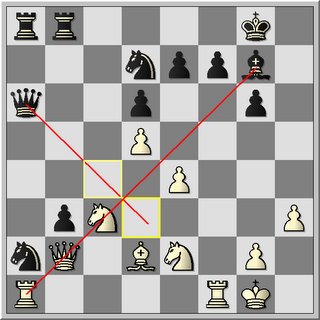
22.Nb4 is the suprise double attack. I want to have the a-pawn. By eliminating one of the pawns black is obtaining the better deal out of this.
24. ... cxb3 and not Rxb3 as it might be very tempting.
25. ... Qd3, I hesistated between Qc4 and Qd3. Qc4 would pressurize the Nc3. As it is three on a row but Qd3 trades off a possible counterplay of white. Increasing the viability of the pawn on b3!
28. Nxc3 Bd4+ 29.Kh1 Rxa1 30.Rxa1 Rc8 (this is FRITZ - a big plus - piece up)
Black's plan is easy. Undermine the two pawns in the center for the loss of extra b-pawn. End result will most likely be two pawns up.
31.Rb1 Nc5 32.Kf2 Rb3 33.Nd1 Nxe4+ 34.Ke2 Nf6 35.Rxb2 Rxb2+ 36.Nxb2 Nxd5
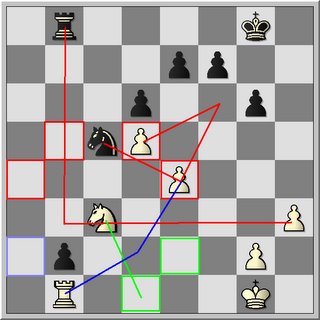
This part is the elimination of the 2 center pawns. Black managed to do this by cripling severely the movement of white's knight. Black's knight controls greatly white's knight. Rb3 forces the knight to move but also severely limits the movements of the white king. Now if black manges to attack with the knight the rook on b1 the game is over. This weakness to prevent this makes his pawns in the center of secundary importance. Well, I went after the two pawns and history was written.
The game
1.d4 Nf6 2.c4 c5 3.d5 b5 4.cxb5 a6 5.Nc3 axb5 6.Nxb5 Qa5+ 7.Nc3 g6 8.Bd2 Bg7 9.e4 d6 10.Bc4 0-0 11.Nge2 Nbd7 12.f4 Ba6 13.Bxa6 Qxa6 14.0-0 Rfb8 15.Qc2 Ne8 16.f5 Ne5 17.fxg6 hxg6 18.b3 Nf6 19.h3 Nfd7 20.Bc1 Nd3 21.Bd2 c4 22.Rab1 Nb4 23.Qb2 Nxa2 24.Ra1 cxb3 25.Be3 Qd3 26.Qd2 Qxd2 27.Bxd2 Nxc3 28.Bxc3 Bxc3 29.Nxc3 Rxa1 30.Rxa1 b2 31.Rb1 Nc5 32.Kf2 Rb3 33.Nd1 Nxe4+ 34.Ke2 Nf6 35.Rxb2 Rxb2+ 36.Nxb2 Nxd5 37.Nc4 Kg7 38.Kf3 Kf6 39.Kg4 Nc3 40.Kf3 d5 41.Nd2 e5 42.Nf1 Ke6 43.g4 g5 44.Ng3 d4 45.Kf2 Kd5 46.Ke1 e4 47.Kd2 Nb5 48.Nf5 Nd6 49.Ne7+ Kc5 50.Ke2 Kc4 51.Nc6 f5 52.gxf5 d3+ 53.Kd2 Nxf5 54.Ne5+ Kd4 55.Nf7 e3+ 56.Ke1 d2+ 57.Kd1 Kd3 58.Ne5+ Kc3 59.Nf3 Ng3 60.Ng1 Kd3 0-1 (Ne4-Nf2 mates also)
Listening to Rimsky-Korsakov's Scheherazade 'The Sea and Sinbad's Ship', this music brings back sweet memories of a daunting quest to slain your opponent in pieces.
Lamp, F - Montse [A57]
J'adoube enjoy the game.
1.d4 Nf6 2.c4 c5 3.d5 b5 4.cxb5 a6 5.Nc3
The Zaitsev Variation

5. axb5
Is a logical answer but alternatives such as 5...Qa5 or 5.. g6 can also be played. Standardly speaking, I just hit the pawn back - is probably best.
6.Nxb5 Qa5+ 7.Nc3 g6 8.Bd2 Bg7 9.e4
Now 6.e4 is a possible continuation and according to IM Steffen Pederson a main line to follow. I tried the aggressive Qa5+. Drawback your queen is early in the game so you have to watch out that it will not become a target. So 7. Nc3 becomes forced and 8.e4 is not immediately possible. So your Knight on f6 is save, for a while at least.
Let's go to position after 8 moves of play.

Now white can play. 9. Ne4 hitting with his dark squared bishop the Queen. On Na4 he looses his knight. Black moves Q to b6 on Ne4 (c7 is possible but might not be as strong),and the only remaining target for white's knight is the defended Knight on f6. This type of play would not beneficial for white, as it would not support his development. By the exchange on f6, black's dark squared bishop has been uncovered and starts to pressurize the b2 a1 square holding back the b-pawn. And already black is in for equalisation.
This is defenitely not the type of play you want to have with white.
Well back to the game!
My opponent played the delicious 9.e4 and here we go.
9.e4 d6 10.Bc4?! 0-0 11.Nge2 Nbd7

Question what might be the idea of Bc4?
Preventing black to play the freeing break with e6 in the future? Bb5+ looks promising but I would say that if you play for the exchange of your bishop for a knight you are looking for small advantage on long term. This long term advantage would only be possible if you manage to halt black's Q-side play by putting up an effective blockade. Easy to say, but very hard to realize. Also you have to take into account that you have weaken your light squares especially d3-c4. When you played e4 to support d5, d3 cannot be longer controlled by a pawn. On the other hand you killed off a very handy knight that might have been very obstructive in realizing your queen side blockade. There might be extra considerations to be made in view of whether white has a fianchetto structure on the kingside or not.
Whatever the reasoning every game has to be played.
11 Nge2 is Ok, but Nf3 would have been more promising. With Nge2 white does not directly challenge black for the control over e5. His plan is simple. Castle short and use f4 for the break. Open up the f-file for his rook. A question one has to ask oneself is what do I obtain after the execution of the plan.
Well a loss of the pawn, I would say. White does nothing to gain control over the e5 square. So logically speaking, first f4 and then follow up with Nf3.
The only merrit that I see for Nge2 is that it safequards whites castling whithout the necessity to trade off queens. It might strenghten Nc3 but it does not help you on the light squares. So black's strategy becomes very clear. Kill off the light square bishop. Get control over e5, push c5 c4 and put a knight on d3.
Back to the game
12.f4?! Ba6 13.Bxa6 Qxa6 14.0-0 Rfb8 15.Qc2
I don't like 12 f4. The pawn push is not supported. Ba6 forces white into a capture. with this the Q has taken control over the diagonal a6-f1. More imortantly over d3. This calls for a beer. First part of the plan OK - get a grip on d3.
With rook b8 black forces white to protect the b-pawn with the Queen.

Second part of the plan. Get a knight on d3. Importantly, if the knight would be exchanged on d3 you don't want to loose the pawn with it. When you recapture with the pawn you may not loose this pawn. Why? Otherwise you will go into a lost endgame! There will be no stopping of white's pawn march along the a and b-file. Even the translocation of the pawn to the d-file might lead to a position hard to maintain. It comes down to piece cooperation.
Now Ne8 with the idea to translocate the Knight to the Q-side.

16.f5?! Ne5 17.fxg6 hxg6
f5 I don't like neither. It creates a hole on e5. As there is no cooperation with the h-pawn, there is no danger to my kingside. As Silman would say, improve your pieces. With Ne5 black increases its grip on the diagonal a6-f1.
Furthermore, black has only to maneuver his second knight to d7 (2 moves) and its already on a railway to d3.
18.b3 Nf6 19.h3? Nfd7 20.Bc1 Nd3 21.Bd2
Ne8 lovely move, coz it might also lead to the support of the e5 knight.

b3 to develop the dark squared bishop to b2, and inhibit the strenght of the g7 bishop but the bishop is on d2 or a4 with knight to b5 and the other knight to c4. Effective blockade of the q-side. He still needs to sort out the rook on a1.
h3 time to see ghosts. WHOOOOOOOOhhhhhh Ng4? Qb6 - c4 idea. No, I got something more stiffling.
It is important to note that from move 18 to 20 his main idea was to improve his position of his dark squared bishop. He realised that after Nd3 his plan was utterly, not to the point.

With Nfd7 black can play Nb6 and support c4, or c4, Nc5. But have you notice the highway to d3 is installed. I would say Alrighty, you almighty @&$*!!!... . Time to chopp your head off. Well we are reaching a critical point in the game. How to cash in? I earn EURO's no dollars. Please take a seat, put the peddle to the middle and do not hit the breaks.
21.Bd2 c4 22.Rab1 Nb4 23.Qb2 Nxa2 24.Ra1 cxb3 25.Be3 Qd3 26.Qd2 Qxd2 27.Bxd2 Nxc3 28.Bxc3 Bxc3 29.Nxc3 Rxa1 30.Rxa1 b2 31.Rb1 Nc5 reaching a winning position.

22.Nb4 is the suprise double attack. I want to have the a-pawn. By eliminating one of the pawns black is obtaining the better deal out of this.
24. ... cxb3 and not Rxb3 as it might be very tempting.
25. ... Qd3, I hesistated between Qc4 and Qd3. Qc4 would pressurize the Nc3. As it is three on a row but Qd3 trades off a possible counterplay of white. Increasing the viability of the pawn on b3!
28. Nxc3 Bd4+ 29.Kh1 Rxa1 30.Rxa1 Rc8 (this is FRITZ - a big plus - piece up)
Black's plan is easy. Undermine the two pawns in the center for the loss of extra b-pawn. End result will most likely be two pawns up.
31.Rb1 Nc5 32.Kf2 Rb3 33.Nd1 Nxe4+ 34.Ke2 Nf6 35.Rxb2 Rxb2+ 36.Nxb2 Nxd5

This part is the elimination of the 2 center pawns. Black managed to do this by cripling severely the movement of white's knight. Black's knight controls greatly white's knight. Rb3 forces the knight to move but also severely limits the movements of the white king. Now if black manges to attack with the knight the rook on b1 the game is over. This weakness to prevent this makes his pawns in the center of secundary importance. Well, I went after the two pawns and history was written.
The game
1.d4 Nf6 2.c4 c5 3.d5 b5 4.cxb5 a6 5.Nc3 axb5 6.Nxb5 Qa5+ 7.Nc3 g6 8.Bd2 Bg7 9.e4 d6 10.Bc4 0-0 11.Nge2 Nbd7 12.f4 Ba6 13.Bxa6 Qxa6 14.0-0 Rfb8 15.Qc2 Ne8 16.f5 Ne5 17.fxg6 hxg6 18.b3 Nf6 19.h3 Nfd7 20.Bc1 Nd3 21.Bd2 c4 22.Rab1 Nb4 23.Qb2 Nxa2 24.Ra1 cxb3 25.Be3 Qd3 26.Qd2 Qxd2 27.Bxd2 Nxc3 28.Bxc3 Bxc3 29.Nxc3 Rxa1 30.Rxa1 b2 31.Rb1 Nc5 32.Kf2 Rb3 33.Nd1 Nxe4+ 34.Ke2 Nf6 35.Rxb2 Rxb2+ 36.Nxb2 Nxd5 37.Nc4 Kg7 38.Kf3 Kf6 39.Kg4 Nc3 40.Kf3 d5 41.Nd2 e5 42.Nf1 Ke6 43.g4 g5 44.Ng3 d4 45.Kf2 Kd5 46.Ke1 e4 47.Kd2 Nb5 48.Nf5 Nd6 49.Ne7+ Kc5 50.Ke2 Kc4 51.Nc6 f5 52.gxf5 d3+ 53.Kd2 Nxf5 54.Ne5+ Kd4 55.Nf7 e3+ 56.Ke1 d2+ 57.Kd1 Kd3 58.Ne5+ Kc3 59.Nf3 Ng3 60.Ng1 Kd3 0-1 (Ne4-Nf2 mates also)


5 Comments:
You better not bring that weak-arsed Benko to me [grin]
I got me a 55 gallon barrel of whoop-ass I'll open up on it. . .
I've already got an answer for the Benko - and have spanked several good players with it already
And I thought I was a systembuilder:)
Tempo,
Indeed, I seems that my approach to chess is as you said. I have learned this opening from an IM in the past. It has been a long time, so the ins and outs I do not remember.
So j'adoube I would be careful
very lovely blog. thank you for alerting me again to it. i LOVE the benko gambit. most aren't ready for it, <2000 elo.
and thanks for your comment. all is well, and new post...
i have a list of persons to link into, and i just added you, and will correct this in week(s) ahead, but with certainty. best regards, david
woops. i already you linked in, but not as montse.
i made a note to move you up in incidence of frequency--i.e. i dont as a matter of course, show favored links to folks who ignore me, or when i wrote them notes virtually ignore all my comments. it gets tiresome....
life is a social process, and an exchange, after all, and not completely a solitary introjection.
best regards, david
Post a Comment
<< Home